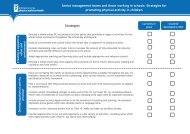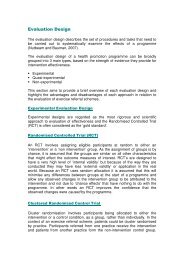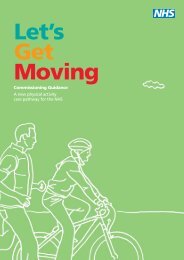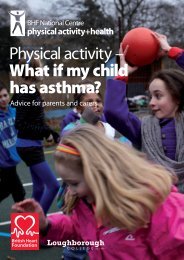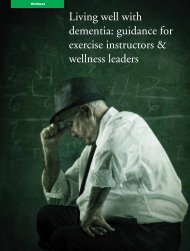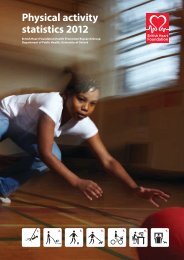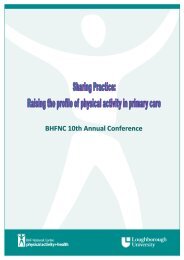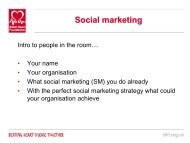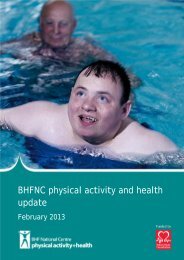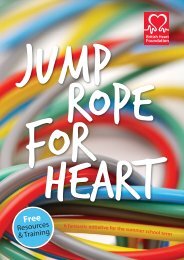5 Practical ideas for physically active play - BHF National Centre ...
5 Practical ideas for physically active play - BHF National Centre ...
5 Practical ideas for physically active play - BHF National Centre ...
- No tags were found...
Create successful ePaper yourself
Turn your PDF publications into a flip-book with our unique Google optimized e-Paper software.
The activities and howthey helpDevelopmental activitiesKicking, reaching and graspingWhat they encourageWe’ve divided the activities below into the threemain types that are important <strong>for</strong> toddlers of thisage. Some of the activities apply to more thanone category, but they’re only listed here once.‘What they encourage’ highlights some ofthe specific movements/developments theactivities encourage.– Hang CDs, rattles or bells on strings where they can kick at them. Later,when they can reach and grasp with their hands, move the objects tochallenge them to reach more or sit and lean to reach. Musical <strong>play</strong> gymscan be useful <strong>for</strong> this.Sitting– Encourage baby to sit on your lap, on the floor between your legs, upagainst a pillow, with cushions placed around.– Movement of arms and legs– Sitting unaided (core strength and balance)– Sitting momentarily leaning on handsDeveloping strength in different positionsFree movement activitiesWhat they encourage– Carry them in different positions, eg, your shoulder, in a sling or baby pouch,with their back against your chest.– Neck and head controlFloor <strong>play</strong>Developing eye strength and tracking of objects– Place favourite toys at the edge of their reach and encourage them toreach and roll over <strong>for</strong> them. You can also use everyday items, but takecare that they’re safe and clean, as most items will end up in their mouthas they explore.– Introduce toys that reward babies by making a noise when they dosomething to them, eg, rattles, balls with bells inside, drums or saucepans,squeaky toys, toys with push-buttons, musical soft toys with crinkly textures.– Rolling from back to front– Stretching or moving to reach toys(keeping balance)– Develop senses– Read picture books with them – practise pointing to objects in the pictures,repeating and demonstrating simple action words <strong>for</strong> them.Balance and body awareness activities– Eye movement and strength– Sitting– Language developmentWhat they encourage– Introduce treasure baskets. These can have a theme or be a mixture, eg, ‘soft’theme – sponge, flannel, cotton wool, soft toy, velour material, ball of wool,soft baby brush.– Demonstrate different actions and use language to describe what you andthey are doing. Use simple action words: up, down, low, high, bounce, sway,jump, rock, over, under, tickle, roll.– Word recognition/language development– Balance (vestibular system)Tummy time– Place colourful, noise-making toys in a circle and slightly out of reach –to encourage reaching and moving and eventually to roll over.– Roll up a towel or blanket, place under their armpits – to encourage them tolift chest and prop on <strong>for</strong>earms.– Try rolling some toys in front of them.– Get down on the floor and interact – sing songs, <strong>play</strong> with toys, placea plastic mirror in front of them.– Neck and head control– Strengthening of neck muscles– To hold chest up when on tummy and takeweight on <strong>for</strong>earms–Rolling from tummy to back– Eye movements– Move them into different positions, eg, lie or sit them on your knees andbounce up and down, put them tummy down, along your arm and swingin the air.– Sit with them on your lap or together on a swing. Gently rock <strong>for</strong>wardsand backwards.– Hold them and gently sway, rock and spin (both directions) to music.– Massage and <strong>play</strong> with their feet, clap their feet together, blow raspberrieson their feet, attach bells to their feet.– Core strengthening of muscles in the neckand trunk– Body awareness– Balance – helped by baby ‘sensing’ objectsaround them– Hold a toy to the side where they can see it and move the toy over their headto land on the other side. They’ll follow it with their eyes and may roll over.– Developing confidence in self andability to move– Play aeroplanes (when sufficient head control is established). Lie on yourback with knees bent up while they lie with their tummy on your shins,facing you.Outdoor <strong>play</strong>– Take them outside, either <strong>for</strong> a walk in their pram or place them on a rug/blanket or grass (if dry), under a tree if possible, to watch the leaves, hangcoloured ribbons or streamers or wind chimes from a tree.– Engaging with nature– Using all senses20 Early movers – Helping under-5s live <strong>active</strong> & healthy livesSection 5 – <strong>Practical</strong> <strong>ideas</strong> <strong>for</strong> <strong>physically</strong> <strong>active</strong> <strong>play</strong> 21



